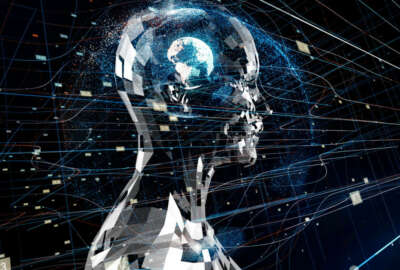

AI research aims not just for brain-like intelligence but also the brain's low power requirements.
Best listening experience is on Chrome, Firefox or Safari. Subscribe to Federal Drive’s daily audio interviews on Apple Podcasts or PodcastOne.
“Ai” used to be a crossword puzzle clue for three-toed sloth, but today it more likely stands for artificial intelligence. In information technology circles, AI is tossed around as a panacea for everything from disease to employee boredom.
If you define AI as the application of algorithms that can learn and evolve as they’re exposed to new data, the use cases do indeed seem endless. The ultimate goal of AI is machinery that acts autonomously but within bounds — such as federal policy on this or that. AI is often and inaccurately described as computers that can think like a human brain. But according to a human brain expert I spoke to recently, don’t hold your breath — that could take another century.
I don’t think serious researchers in AI see the creation of a “brain” as the goal per se. Machines that can make auditable decisions in specific domains are more to the point. Even that gets complicated because of how data source selection can bias even the most capable algorithms.
Dr. Walter Koroshetz, the director of the National Institute of Neurological Disorders and Stroke, pointed out the brain has 85 billion neurons and maybe a trillion interconnections. He said he chuckles at the idea of a computer equaling a human brain in our lifetimes. Even with the level of brain mapping accomplished so far, Koroshetz said, “We may know something about some of the letters the brain uses. But we don’t know the words, we don’t know the sentence structures.”
Until the brain structure and ways it processes information are exponentially better understood, how could anyone build an artificial one?
Koroshetz’s agency just announced more than $220 million in grant funding to researchers under its Brain Research through Advancing Innovative Neurotechnologies initiative, or BRAIN. Among the goals is more detailed brain mapping, to understand more deeply the organ’s mysterious workings.
It turns out the brain research and AI research complement one another in a field called neuropathic computing. Its goal is not simply highly gifted machines, but rather machines which can do their work at power levels approaching those of the brain. Given what it does, the brain is a very low power device, maybe 20 watts. Fun fact: The brain is only 2 percent of the body’s weight but it consumes 20 percent of your metabolic output. Supercomputers that can perform at petaflops (a unit of computing speed equal to 1,000,000,000 million or 1015 floating-point operations per second) practically require their own electrical generating stations.

Many federal grant-making agencies are pursuing some piece of neuropathic research. Besides NIH, they include the National Science Foundation, National Security Agency and the Air Force.
If the world depended on me for the cutting edge of science and technology, we’d still be wrapped in skins around a fire put, barbecuing goat bones. So I find all of this both interesting and exciting. A convergence of real brain and artificial brain research — what a thought.
Copyright © 2025 Federal News Network. All rights reserved. This website is not intended for users located within the European Economic Area.
Tom Temin is host of the Federal Drive and has been providing insight on federal technology and management issues for more than 30 years.
Follow @tteminWFED
